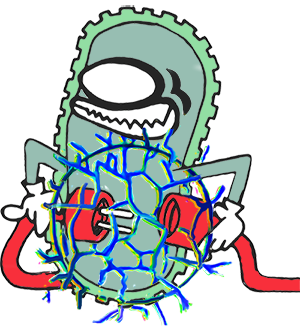Team:TU Delft-Leiden/WetLab/landmine/theory
From 2014.igem.org
| Line 12: | Line 12: | ||
<p> | <p> | ||
| - | + | <i>return to the <a href="https://2014.igem.org/Team:TU_Delft-Leiden/WetLab/landmine"> <b> Module Landmine Detection </b> </a></i> | |
</p> | </p> | ||
<br> | <br> | ||
Revision as of 17:00, 14 October 2014
Context
return to the Module Landmine Detection
In the literature [1] a very interesting type of biosensor was found: two natural promoters of Escherichia coli (ybiJ and yqjF) were found to be activated in the presence of some aromatic N-based compounds such as 2,4,6-Trinitrotoluene (2,4,6-TNT), 2,4-Dinitrotoluene (2,4-DNT) and 1,3-Dinitrobenzene (1,3-DNB). Land mines are mainly composed of 2,4,6-TNT, but many times impurities of 2,4-DNT and 1,3-DNB are also present. These last two compounds are more volatile than 2,4,6-TNT and, therefore, they can more easily leak out of the land mine. As a consequence, Belkin and co-workers envisioned in the two aforementioned promoters (ybiJ and yqjF) a high potential to develop a biosensor for land mine detection.
This was a very attractive case of study to implement the Plug-and-Play biosensor based on electrical current developed by our team.
Coupling the promoters to our system
As a final goal, it was desired to link the ybiJ and yqjF promoters to the generation of an electrical current. Therefore, it was our intention to express two of the three genes of the mtrCAB pathway independently (either constitutively or regulated via an inducer) and the last mtrCAB gene regulated by one of the two promoters induced by land mine compounds. Hence, the presence of land mines would trigger the expression of the lacking gene of the mtrCAB pathway, and therefore, it would start the secreation of electrons out of the cell. This way, it was intended to correlate the presence of the abovementioned chemicals present in land mines with a certain electrical current.
It was, nevertheless, more convenient to test the selected promoters with a more easily measurable reporting system
Choosing a reporter gene
To initially check the functionality of the ybiJ and yqjF promoters, a fluorescent protein mKate2 was chosen as a reporter. mKate2 was selected instead of the conventional Green Fluorescent Protein (GFP) because it has been observed to be more evenly expressed among the different cells of a cellular culture than GFP.
References
[1] S. Yagur-Kroll, S. Belkin et al., “Escherichia Coli bioreporters for the detection of 2,4-dinitrotoluene and 2,4,6-trinitrotoluene”, Appl. Microbiol. Biotechnol. 98, 885-895, 2014.
 "
"






